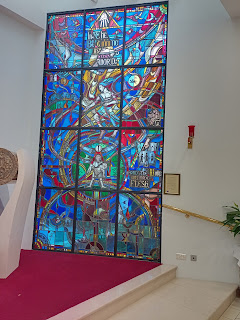I'd never been to the Church of the Divine Word, but I must say, it might be the most beautiful church I've ever attended.
It's quite a small, simple church. It doesn't really have any nooks and crannies, aside from a shrine of our Lady which is just behind the altar. It's rather minimalist.
It has the sort of atmosphere that I always think of as "spacey". Otherworldly, bright, sleek. I suppose I associate this aesthetic with space-ships and space stations in science fiction films and television, and it's an atmosphere (for me) full of awe and wonder and a sense of limitless discovery.
The beautiful stained glass is the most striking feature of the church, especially the panel behind the altar (below). I assumed the website would tell me the name of the artist, but I can't find it. It's very much in the style of the Celtic Revival, which I like.
What I like most about the Celtic Revival was its determination to break into a new aesthetic "space". I hate to use that kind of language, but I can't think of a better term. The attitude of the Celtic Revival (and the Gaelic Revival) seemed to be: "Everything is going to be different now, we are going to remake everything." There was a world-creating energy about it, a sort of spiritual independence, an assertion of a Celtic future as well as a Celtic past. There's a newness about everything that partakes of that aesthetic; not only a newness, but a timelessness. That's the best I can do to describe it. This church was built in the early eighties, but the stained glass certainly seems inspired by the Celtic Revival. And, even if it's not, it reminds me of it.
 |
As it's a Servite church, there was a prayer to St. Peregrine after Mass, and exposition of a relic belonging to him.








It may be an impressive window but I got one would need an interpreter to understand it enough to pray in front of it.
ReplyDeleteDefinitely no expense with the building materials in that church.
I agree, it's not clear exactly what it represents!
DeleteI could be facetious and ask whether that was Legolas in the middle?
ReplyDeleteI assumed it was Adam, or a representation of man in general.
DeleteI'm getting the impression that nobody is going to sympathise with my taste for more modern churches.
I do see what you mean here. I find myself wishing that the windows were pointed, but the church does look cosy, which I find very important.
Delete